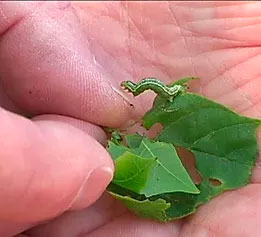
If you’ve noticed the wide expanse of leafless trees along the highway as you drive toward Cape Cod, you have seen the result of winter moth caterpillar’s voracious appetite. The caterpillar has caused widespread defoliation of many deciduous tree species including: oaks, maples, ash, elm, and some spruce. As feeding continues however, the caterpillar will move to feed upon most any variety of tree.
The moths originally came from Europe and established themselves in the Canadian Maritimes. They recently emerged in maritime New England and have slowly spread westward. The resultant defoliation depletes trees resources, and repetitive defoliation can result in the eventual death of the tree. Trees may die from resource depletion alone, or because’ of increased susceptibility to environmental stress and invasion from other insects and diseases.
This is not the first time winter moth infestations have done extensive damage to wooded areas. There was a dra- matic infestation in Nova Scotia in the 50’s and another in the Pacific Northwest in the 70’s. In each of these prior outbreaks the parasitic fly C. albicans was established to feed on the insect. The success of the fly eventually overcame the caterpillar. The parasitic fly preys only on winter moths. This is important, as its population will swiftly decline once the caterpillar is under control, and it will not spread to feed upon other potentially beneficial insects.
Entomologists from the University of Massachusetts Amherst have begun a six-year campaign to control winter moth with the release of C. albicans. The initiative is headed up by U-Mass Amherst Professor Joseph Elkington. The fly was released in Wellesley, Hingham, Seekonk and Falmouth in 2010. Evidence has shown that the fly successfully overwintered last spring, and has begun to prey on the moth’s offspring.
UMass Amherst Winter Moth Control Project was started in 2005 with support from the Mass Legislature. In 2011 Professor Elkinton and his team released about 700 flies at each of nine new sites bringing the total number of towns where the fly has been released to 13. They have also ramped up their ability to propagate the fly species, which will enable the project to distribute them into more and more towns in the near future. It will take time for a few thousand flies to catch up with the trillions of winter moths gorging their way across the Bay State. It is estimated that a noticeable decline in damage will be apparent in two years and the caterpillars will cease to be a significant problem in approximately 5 years. In the mean time, professional control strategies should be used to protect infested trees.

Controlling damage caused by the caterpillar is complicated due to its unusual life cycle. Only the male of the species is able to fly, and thousands of light brown male moths can be seen taking flight on warmer winter evenings primarily in November and December. The female caterpillar crawls up the trees trunk from its base, they then mate with the males and lay eggs on the dormant buds of the trees. Each female lays around 150 eggs which hatch in the early spring just prior to bud break. The tiny caterpillar begins to feed on buds and emerging leaves. This “bud feeding” leaves a distinct pattern to leaf damage. A small hole bored through a bud will expand with the leaf as it grows, in a similar way to how a hole made in a balloon expands when it is stretched. Because leaf tissue is tightly packed within the bud, one tunnel can pierce the flesh of the leaf repeatedly, giving rise to many seemingly separate holes across the surface of the same leaf.
Another problem with this inter-bud feeding is that the pest can remain out of the reach of topical insecticides. The best control measure includes the application of sticky tape around the trunk to prevent the female caterpillars from climbing into the trees canopy where the eggs are
laid.
This combined with tree spraying at bud break with either B.t. (Bacillus thuringiensis) or a similar product called Spinosad should provide excellent overall control. Both B.t. and Spinosad are natural products that have no detrimental effects on people, pets, or the environment. Thousands of homeowners across Eastern Massachusetts have had to employ spray programs such as this to protect their trees. Like previous
infestations of Gypsy Moth Caterpillars in the 80’s it is nice to know that a natural parasite will eventually control this pest, saving consumers millions of dollars in their overt attempts to control its damage. If Winter Moth Caterpillar has damaged trees on your property please call us so we may take appropriate measures to preserve them.
Written By: Terence Boots
Massachusetts Certified Arborist
Owner: Emerald Acres Inc.
